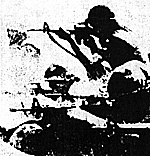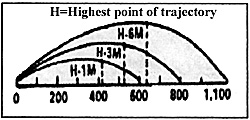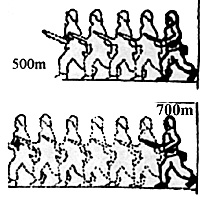 This quick article follows up a couple of discussions I`ve had with some of you by phone and mail. Please treat this more as a set of notes, perhaps for discussion via CHAINMAIL. I hope it provides food for thought, particularly for those writing your own wargame rules.
This quick article follows up a couple of discussions I`ve had with some of you by phone and mail. Please treat this more as a set of notes, perhaps for discussion via CHAINMAIL. I hope it provides food for thought, particularly for those writing your own wargame rules.
In all cases I`m referring to general service weapons and not specialised weapons of elite units, whose constant training and greater capabilities allow them to overcome many weapon`s disadvantages.
QUOTE
"I`m not interested in how or where a weapon is made, as long as it does the job it needs to do and I know how to use it. As long as it fires ammunition and you`ve got lots of it, that`s all you should be concerned about."
Andy McNab (The one that didn`t get away)
PHYSIOLOGY
"Weapons are only as good as their handlers"
Before we go any further, let`s first look at the often neglected human factor.
Our bodies have a natural rythm of movement created by our heartbeat and breathing, which in turn effects chest, neck, arms and hands. Pulse and respiration slow when you are relaxed and similarly increases dramatically due to excitement, exercise and fear ! This movement is transmitted to the end of the weapon you`re trying to aim. That little wobble is enough to throw the bullet wide at 300m.
Fatigue and illness must be taken into account, as do the extremes of temperature. A fatigued or out of condition soldier will find his muscles trembling after holding a weapon in the firing position for a few shots; and you can`t aim too well if you`re shivering. That Russian in his bulky padded snow suit is more likely to get a better shot than the German wrapped in a greatcoat with newspaper for lining.
A stable position and firm stance is crucial for a well aimed shot. Standing is the poorest firing position, though leaning against a tree, wall etc is an improvement. Accuracy is increased substantially by resting the weapon. Firing from a kneeling position gives a very stable platform, though prone is the best - muscular tensions are reduced and body rythm is dampened. Both elbows are supported by the ground
Supporting the weapon barrel with a bipod such as some versions of the FN FAL or the FG42, or simply bracing it on a sandbag, greatly increases the chance of a first round hit. Resting the weapon between crossed ski poles is also surprisingly accurate.
BALLISTICS
A quick look at basic ballistics.
From the moment a round leaves the barrel it becomes a prisoner of gravity and drag (air resistance). The further the bullet has to travel, the longer it is exposed to gravity, and the greater the 'drop' in it`s trajectory. The round will cover the first 30% of it`s range at around twice the speed of sound so the effects of gravity are low, but drag effects are high. As the bullet begins to slow, the proportional effects swing till at 60% of maximum range, the drag is small but the forces of gravity high enough to cause the bullet to drop very fast.
 If we agree that line of sight (LOS) is perfectly straight, then the bullet path will drop below the LOS at around 30% of range. Weapon sights are designed to be raised to increase the angle of the barrel and therefore bullet path. In this case the bullet path rises above the LOS very quickly, then drops till it intersects LOS again, hopefully either on or close to the target.
If we agree that line of sight (LOS) is perfectly straight, then the bullet path will drop below the LOS at around 30% of range. Weapon sights are designed to be raised to increase the angle of the barrel and therefore bullet path. In this case the bullet path rises above the LOS very quickly, then drops till it intersects LOS again, hopefully either on or close to the target.
Notice in this chart for the M16A1 rifle that the trajectory rises to 6 metres when the sights are adjusted to fire at 1,100 metres. At 800 metres the round reaches a maximum "ordinate" of 3 metres. A panicked soldier who forgets to lower his sights will in this instance be firing above the heads of oncoming troops until they reach 200 metres ! Can you see now why so many mounted officers become casualties, they`re not beigger targets, just taller ones !
Many wargame rules have detrimental modifiers for shooting with fixed bayonets. The weight of the bayonet alters the balance of the weapon, generally making the firer shoot low. At 300m or less, this actually compensates for those men who have forgotten to lower their sights in the heat of the moment.
The US Army believe that infantry combat rarely occurs over 300 metres. So the M16`s sights are "zeroed" at 25 and 250 metres. That is, the round will fly low up to 25m, between 25 and 250 metres it will shoot high and after 250 metres fly low again - striking the earth between 320-350 metres.
A point to know for skirmish / RPG games where a soldier can pick up a discarded weapon or for wargames where figures take over a machine-gun whose crew are dead, is that a) weapons are zeroed to reflect the owner`s characteristics, i.e. relationship between eye and back sight. b) user must be aware of the weapon`s characteristics - i.e. zeroing and trajectory ?
There are also minute but innate differences between rounds so that two rounds are unlikely to hit the exact same spot. When several rounds are fired in a burst, each one will take a different trajectory due to variations in the ammunition, vibration from recoil and atmospheric conditions. This produces what is known as a cone of fire.
The recoil from the first and subsequernt rounds progresively disturbs the lay of the weapon. This is not good for a rifleman firing at an individual target, though a tight cone actually gives more chance of a hit with one of the rounds. However a machine-gun should have a wider cone to score hits on multiple targets. One of the crtitiscms of the Bren gun was that it was "too accurate", i.e. had a small cone.
Atmospherics
Rain causes a round to lift, whilst even "still" air will see a .303 round drift up to seven feet to the left at 1,400 yards.
After 300 metres, winds have an effect upon the bullet`s performance, with the effect being greater as the range increases. Winds that blow either into the target or firer`s face can be discounted. Winds that blow directly either from the 9 o`clock or 3 o`clock positions have most effect. Those that blow at an angle will have half that effect.
It`s hard to judge exactly how performance will be impaired, as winds might be different at target than firer`s position and the bullet path may be protected by buildings, trees, brush or terrain.
Accuracy is also effected by the fouling of rifling by combustion soot. After about 80 rounds of rapid fire, the barrel will expand, this again results in loss of accuracy.
THE TARGET
"...due to the smallness of the aiming mark he can see, regardless of the qualities of the weapon, the average soldier under the stress of combat in any era is incapable of very much accuracy with a shoulder arm at ranges greater than the Napoleonic 'fifty or one hundred yards'...."
A Great War British instructor would have told you that at 50 yards you could distinguish eyes & mouth on your target, dots for eyes at 100 yards, the face would become indistinct at 300, whilst head and cap could just be made out at 500.
By World War Two, your instructor would place his thumb 12" in front of his nose and tell you that if the enemy was the size of your thumb, he was 50 yards away; from the knuckle to tip, 100 yards; and size of the thumbnail, at 300 yards range. Try it !
The average dimensions of a man-size target are :
-
Width : 18"
Height :
Standing Firing 5 ft 4"
Kneeling Firing 43"
Sitting, behind HMG 32"
Firing from trench etc. 24"
Prone 18"
"In the British Army, you are taught how to react when the enemy opens fire : you dash to make yourself a hard target, you get down, you crawl into a fire position, find the enemy, set your sights at the range and fire"
Andy McNab
The point here is that if you don`t get him with the first shot, the enemy is likely to instantly become a much smaller target. I`ll come on to tactical firepower in a later issue.
Aim
Most armies teach their soldiers to shoot at the target`s centre of mass. ie. Don`t get poncey and aim for his head, trigger finger, etc. Shoot at where the round has most chance of striking regardless of whether it travels up, down, left or right !
 These are the two most common sights found on military weapons.
These are the two most common sights found on military weapons.
However, if the target is moving obliquely or across your front or obliquely to you, then you must allow some lead. That is, fire ahead of the target so that the bullet and target reach the same spot at the same time.
 The illustration on the right is from a Spanish Civil War training manual. It shows in graphic form for largely illiterate soldiers that you must give one whole body distance at 300m, two at 400m, four at 500m and six at 700m.
The illustration on the right is from a Spanish Civil War training manual. It shows in graphic form for largely illiterate soldiers that you must give one whole body distance at 300m, two at 400m, four at 500m and six at 700m.
With a machine-gun it`s easier, you just fire into the space you think the enemy is likely to run into.
The following table taken from The Tub, newsletter of the SFSFW Games Design Study Group by Mathew Hartley, shows test results of hits with an M16 rifle.
The top line shows the weapon bench clamped in lab conditions. The next line is the best score recorded by a top grade marksman, and the bottom shows the results by average troops in simulated battle conditions.
100 metres proves to be an important watershed, with the accuracy of both marksman and average troops dropping dramatically at ranges greater than this. A fact reflected in so many sources and regardless beit smoothbore black powder musket or modern assault rifle.
NEXT TIME: Tactical fire, lethality and the effects of cover / protection

Back to The Gauntlet No. 9 Table of Contents
Back to The Gauntlet List of Issues
Back to Master Magazine List
© Copyright 1997 by Craig Martelle Publications
This article appears in MagWeb (Magazine Web) on the Internet World Wide Web.
Other military history articles and gaming articles are available at http://www.magweb.com